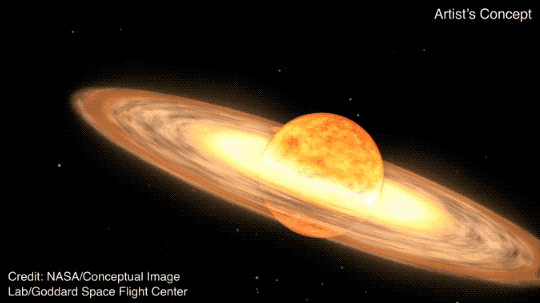A Rare Nova Explosion Will Soon Bring a ‘New Star’ to the Night Sky—How to Catch a Glimpse
In an event that occurs only once every 80 years, a distant remnant of a star will grow much brighter, briefly becoming visible to Earth

At some point during the next several months, a distant, dead star will rapidly grow brighter in a powerful explosion, making it visible from Earth for a short period of time. To observers on the ground, it will look like a new star.
The dead star—which is currently not bright enough to appear in the sky—is one of a pair that orbit each other in a binary system called T Coronae Borealis, or T CrB. Known as a white dwarf, this leftover stellar core is snatching material from its neighboring red giant. When it gathers enough, roughly every 80 years or so, the white dwarf releases energy in a bright outburst, according to NASA.
Astronomers excitedly await the short-lived event. “When T CrB goes off, a large fraction of every telescope in the world is going to be pointed at it,” Bradley Schaefer, an astrophysicist at Louisiana State University, tells Scientific American’s Robin George Andrews.
T CrB is located 3,000 light-years from Earth. The astronomer John Birmingham observed its outburst from western Ireland two explosions ago, in 1866, according to Nicole Mortillaro of the Canadian Broadcasting Corporation (CBC). Then, it flared up again in 1946. There’s also evidence that it was seen in 1787 and 1217, per the New York Times’ Robin George Andrews.
Such an event is called a nova—a rapid increase in the brightness of a white dwarf that reignites after years of slumber. These outbursts are different than supernovae, which are much more dramatic. Supernovae occur when a dying star erupts in a release of energy that can briefly outshine galaxies.
In systems like T CrB, a white dwarf is locked in a dance with a red giant, a star that has run out of fuel and begun to die. The red giant swells in size, its temperature and pressure increasing, and starts to eject its outer layers. A lot of this material is hydrogen gas, which gets slurped up by the white dwarf. Eventually, the white dwarf grows hot enough on its surface—a temperature of about 10 million Kelvin—to produce a nuclear explosion.
“These novae are basically hydrogen bombs,” Schaefer says to the New York Times.
How to see the nova explosion
/https://tf-cmsv2-smithsonianmag-media.s3.amazonaws.com/filer_public/2f/f3/2ff324f4-b924-41ed-a42b-f3ff90fef31c/findhercules_nsn896.webp)
The T CrB white dwarf is usually too dim to see from Earth with the naked eye. But at the peak of its explosion, it will appear as bright as the North Star. You won’t need any special equipment to see it.
“T Cor Bor goes from its lowest level, which it’s just trundling along at right now, to its peak [in about] three hours or something like that—it’s really fast,” Schaefer tells the CBC.
The bright blast will appear in the constellation Corona Borealis, a small, semicircular arc between the constellations Hercules and Boötes. If you want to witness the event yourself, NASA advises becoming familiar with Corona Borealis before the fleeting explosion.
You should be able to see T CrB with the naked eye for several days and with binoculars for just over a week, according to NASA.
“It’s short,” Schaefer tells National Geographic’s Adam Kovac. “It stays at peak brightness only a few hours and starts fading fast.”
When will the nova occur?
Astronomers don’t have an exact time for when the blast will go off, but they’re refining their guesses based on the behavior of T CrB’s last nova.
“We know from the last eruption back in 1946 that the star will get dimmer for just over a year before rapidly increasing in brightness,” William J. Cooke, the lead for the NASA Meteoroid Environments Office, tells CNN’s Ashley Strickland. “T Coronae Borealis began to dim in March of last year, so some researchers are expecting it to go nova between now and September.”
“We’ve been following it worldwide, and it’s been doing some fun things,” Sumner Starrfield, an astrophysicist at Arizona State University, tells National Geographic. “It got brighter for a few years and now has faded a bit. It seems to be doing pretty much the same thing it did just before it exploded in 1946, which is why we’re suddenly very interested.”
When the light from the explosion does appear in Earth’s skies, it will be a rare moment in astronomy. T CrB is one of just ten recurring novae in the Milky Way galaxy, Cooke tells CNN.
“The fact that it’s recurring on a timescale we could work with, as far as humans are concerned… makes it very special,” Paul Delaney, an astronomer at York University in Canada, says to the CBC.
“It’s a once-in-a-lifetime occurrence,” Cooke tells the New York Times. “How often can people say that they’ve seen a star explode?”
/https://tf-cmsv2-smithsonianmag-media.s3.amazonaws.com/accounts/headshot/Will-Sullivan-photo.png)
/https://tf-cmsv2-smithsonianmag-media.s3.amazonaws.com/accounts/headshot/Will-Sullivan-photo.png)